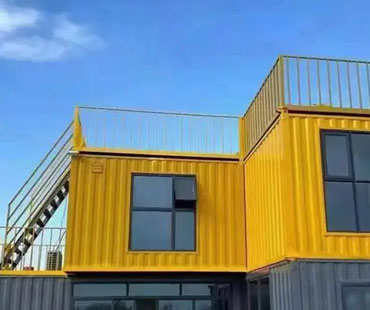Shipping container homes have emerged as an innovative solution for modern living, combining sustainability, affordability, and adaptability. With rising urban populations and growing interest in eco-friendly housing, these modular homes offer a unique opportunity to rethink how we use space. While their industrial origins might suggest limitations, innovative interior design strategies can transform these compact spaces into functional, stylish, and comfortable living environments. This article explores the principles and techniques for maximizing the potential of shipping container homes, emphasizing creativity, efficiency, and livability.
1. Embracing the Compact Nature of Shipping Containers
Shipping containers are typically 8 feet wide, 8.5 feet tall, and either 20 or 40 feet long. Their narrow footprint presents unique challenges and opportunities for interior design:
Open-Plan Layouts: One of the most effective ways to maximize space is by using open layouts. Combining the living, dining, and kitchen areas into a single continuous space minimizes visual clutter and creates a feeling of spaciousness.
Vertical Space Utilization: Containers have a height advantage, allowing designers to incorporate lofted sleeping areas or storage solutions. High shelves, hanging cabinets, and wall-mounted storage take advantage of vertical space without compromising floor area.
Multi-Functional Furniture: In small spaces, furniture that serves multiple purposes is essential. Foldable tables, sofa beds, and storage ottomans provide functionality while conserving space.
By accepting the compact dimensions as a design feature rather than a limitation, residents can create a home that feels open and organized.
2. Lighting and Illumination Strategies
Lighting plays a critical role in making a container home feel larger and more inviting. Since containers can feel narrow or enclosed, proper illumination is essential:
Natural Light Maximization: Installing large windows, skylights, or glass doors brightens the interior and connects it to the outdoors. Floor-to-ceiling windows or sliding glass panels can also create the illusion of a larger space.
Layered Artificial Lighting: Using multiple layers of light, including ambient, task, and accent lighting, ensures that every corner of the home is functional and visually appealing. LED strip lighting under shelves or along staircases can add depth and warmth.
Reflective Surfaces: Mirrors, glossy finishes, and light-colored walls amplify light, making spaces feel more expansive.
By thoughtfully designing lighting, even a compact container home can feel airy, bright, and welcoming.
3. Creative Storage Solutions
In a container home, storage is a crucial aspect of design. Every inch of space must serve a purpose:
Built-In Storage: Incorporating cabinets and shelves into the walls reduces clutter while maintaining clean lines. Under-bed storage or pull-out drawers within seating areas provides hidden solutions.
Vertical Storage Units: Tall cabinets, wall-mounted racks, and overhead shelves maximize space utilization.
Hidden Compartments: Cleverly designed spaces, such as stair drawers, fold-down tables with storage, or ceiling-mounted racks, keep essential items accessible without crowding the living area.
Innovative storage solutions maintain a minimalist aesthetic while addressing practical needs.

4. Flexible Partitioning and Zoning
Although open-plan layouts are essential for spaciousness, some areas may require privacy or separation:
Sliding or Foldable Partitions: Movable walls or sliding panels allow residents to create temporary private spaces without permanently shrinking the living area.
Curtains and Screens: Lightweight fabric dividers or accordion screens can separate sleeping areas or workspaces while remaining visually flexible.
Raised Platforms: Lofted sleeping areas or platforms can define zones without adding walls, preserving openness while introducing functional hierarchy.
These strategies allow for multi-purpose use, adapting to changing lifestyle needs.
5. Material Selection and Color Palette
The choice of materials and colors directly affects the perception of space and comfort:
Light and Neutral Colors: Whites, pastels, and light grays make small spaces feel larger and brighter.
Natural Materials: Wood, bamboo, or cork flooring adds warmth and texture, softening the industrial feel of metal containers.
Durable and Lightweight Surfaces: Compact spaces require materials that are easy to clean, maintain, and resistant to wear, especially in high-traffic areas.
Balancing aesthetic appeal with functionality ensures that the container home remains inviting and practical.
6. Outdoor Integration and Expansion
Shipping container homes often benefit from connecting indoor spaces with outdoor areas:
Decks and Patios: Extending living areas to the outdoors can enhance perceived space and provide additional recreational areas.
Green Spaces: Vertical gardens, rooftop planters, and surrounding landscaping integrate nature into the home, improving aesthetics and air quality.
Sliding Glass Walls: Large glass doors blur the boundary between inside and outside, expanding visual and functional space.
By integrating outdoor elements, container homes feel larger and provide residents with a connection to nature, which is especially valuable in urban environments.
7. Technology and Smart Living
Compact homes benefit significantly from smart home technologies that optimize convenience and efficiency:
Smart Lighting and Climate Control: Automated lighting and temperature systems ensure energy efficiency while enhancing comfort.
Space-Saving Appliances: Compact, multi-functional kitchen appliances and washing units reduce clutter.
Integrated Entertainment and Connectivity: Wall-mounted TVs, built-in sound systems, and hidden wiring maintain a clean, modern look.
Smart design enhances livability without requiring additional square footage.
Shipping container homes demonstrate that compact living does not mean sacrificing style, functionality, or comfort. By embracing vertical space, using innovative storage, optimizing light, employing flexible partitions, selecting appropriate materials, integrating outdoor spaces, and leveraging smart technologies, residents can maximize the potential of these modular structures.
Compact living can truly have amaximum impact: shipping container homes, when thoughtfully designed, offer sustainable, flexible, and aesthetically pleasing solutions that meet the demands of modern urban lifestyles. They represent a shift in how we think about housing—prioritizing efficiency, adaptability, and creativity while challenging conventional notions of space and design.


